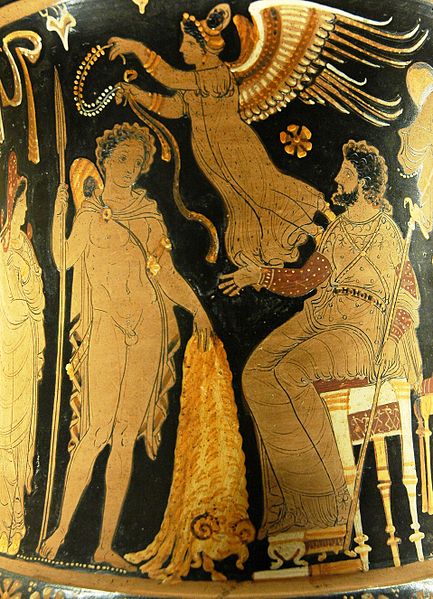Golden Fleece
Página 1 de 1.
 Golden Fleece
Golden Fleece

Jason returns with the Golden Fleece on an Apulianred-figurecalyx krater, ca. 340–330 BCE
Golden Fleece
From Wikipedia, the free encyclopedia
Jump to: navigation, search
This article is about the mythological creature. For other uses, see Golden Fleece (disambiguation).

 Jason returns with the Golden Fleece on an Apulian red-figure calyx krater, ca. 340–330 BCE
Jason returns with the Golden Fleece on an Apulian red-figure calyx krater, ca. 340–330 BCEIn Greek mythology, the Golden Fleece (Greek: Χρυσόμαλλον Δέρας; Georgian: ოქროს საწმისი) is the fleece of the gold-haired[1] winged ram, which can be procured in Colchis. It figures in the tale of Jason and his band of Argonauts, who set out on a quest by order of King Pelias for the fleece in order to place Jason rightfully on the throne of Iolcus in Thessaly. The story is of great antiquity – it was current in the time of Homer (eighth century BC) – and, consequently, it survives in various forms, among which details vary. Thus, in later versions of the story, the ram is said to have been the offspring of the sea god Poseidon and Themisto (less often, Nephele or Theophane). The classic telling is the Argonautica of Apollonius of Rhodes, composed in mid-third century BC Alexandria, recasting early sources that have not survived. Another, much less-known Argonautica, using the same body of myth, was composed in Latin by Valerius Flaccus during the time of Vespasian.
Contents [hide]
<LI class="toclevel-1 tocsection-1">1 Synthesised plot synopsis <LI class="toclevel-1 tocsection-2">2 Evolution of plot <LI class="toclevel-1 tocsection-3">3 Interpretations <LI class="toclevel-1 tocsection-5">4 See also <LI class="toclevel-1 tocsection-6">5 References |
Gods
|
Heroes
|
Related
|
 Greek mythology portal Greek mythology portal |
On the ram the children escaped over the sea, but Helle fell off and drowned in the strait now named after her, the Hellespont. The ram spoke to Phrixus, giving him heart,[7] and took Phrixus, whose name means "curly"—as ram's fleece—safely on to Colchis (modern-day Georgia), on the easternmost shore of the Euxine (Black) Sea. Phrixus then sacrificed the ram to Poseidon[8] and settled in the house of Aietes, son of Helios the sun-Titan, and lived to a ripe old age. He hung the Golden Fleece reserved from the sacrifice on an oak in a grove sacred to Ares, where it was guarded by a dragon. There it remained until taken by Jason. The ram became the constellation Aries.
[edit] Evolution of plot
The very early origin of the myth in preliterate times means that during the more than a millennium during which it was to some degree or other part of the fabric of culture its perceived significance can be expected to have passed through numerous developments.
Pindar employed the quest for the Golden Fleece in his Fourth Pythian Ode (written in 462 BC), though the fleece itself is not in the foreground; when Aeetes challenges Jason to yoke the fire-breathing bulls, the fleece is the prize: "Let the King do this, the captain of the ship! Let him do this, I say, and have for his own the immortal coverlet, the fleece, glowing with matted skeins of gold".[9]
Where the written sources fail, through accidents of history, sometimes the vase-painters preserve the continuity of a mythic tradition. It seems that the story of the Golden Fleece had little resonance for Athenians of the Classic age, for only two representations on Attic painted wares of the fifth century have been identified, a krater at the Metropolitan Museum of Art and a kylix in the Vatican collections.[10] In the kylix painted by Douris, ca 480-470, Jason is being disgorged from the mouth of the dragon, a detail that does not fit easily into the literary sources; behind the dragon, the fleece hangs from an apple tree. Jason's helper in the Athenian vase-paintings is not Medea— who had an untoward history in Athens as the opponent of Theseus— but Athena.
[edit] Interpretations
Euhemeristic attempts on the part of readers whose own cultural background dismisses the mythic fleece as a fanciful object have interpreted the Golden Fleece "realistically" as reflecting some actual cultural object or alleged historical practice grounded in economics: for example, in the twentieth century it was suggested that the story of the Golden Fleece signified the bringing of sheep husbandry to Greece from the east;[11] in other readings more schooled in mythology it would refer to golden grain,[12] or to the sun.[13]

 A sluice box used in placer mining.
A sluice box used in placer mining.A more widespread interpretation relates it to a method of washing gold from streams that is well attested (but only from c. 5th century BC) in the region of Georgia to the east of the Black Sea. Sheep fleeces, sometimes stretched over a wood frame, would be submerged in the stream, and gold flecks borne down from upstream placer deposits would collect in them. The fleeces would then be hung in trees to dry before the gold was shaken or combed out. Alternatively, the fleeces would be used on washing tables in alluvial mining of gold or on washing tables at deep gold mines.[14] Judging by the very early gold objects from a range of cultures, washing for gold is a very old human activity. Thus Strabo describes the way in which gold could be washed:
- It is said that in their country gold is carried down by the mountain torrents, and that the barbarians obtain it by means of perforated troughs and fleecy skins, and that this is the origin of the myth of the golden fleece—unless they call them Iberians, by the same name as the western Iberians, from the gold mines in both countries.
Another interpretation rests on references in some versions to purple or purple-dyed cloth. The purple dye extracted from snails of the Murex and related species was highly prized in ancient times, and clothing made of cloth dyed with Tyrian purple was a mark of great wealth and high station (hence the phrase “royal purple”). The association of gold with purple is thus natural and occurs frequently in the literature.[15]
However, archeologists have rejected these interpretations as ahistorical. An attempt to construct a most plausible explanation by locating it in what is known of the culture in which the story arose points to the interpretation that the Golden Fleece represents the ideas of kingship and legitimacy; hence the journey of Jason to find it, in order to restore legitimate rule to Iolcos.[16]
[edit] Main theories

 Medea statue holding the Golden Fleece in the center of Batumi (One of the major cities of Colchis), Georgia.
Medea statue holding the Golden Fleece in the center of Batumi (One of the major cities of Colchis), Georgia.The following are the chief among the various explanations that have been offered, with notes on sources and major critical discussions:
- It represents royal power.
- Marcus Porcius Cato and Marcus Terentius Varro, Roman Farm Management (“A Virginia Farmer” (1918), Roman Farm Management, The Treatises of Cato and Varro, Done into English, with Notes of Modern Instances on-line text)
- Braund, David (1994), Georgia In Antiquity, Oxford: Clarendon Press, pp. 21-23
- Popko, M. (1974) “Kult Swietego runa w hetyckiej Anatolii” [“The Cult of the Golden Fleece in Hittite Anatolia”], Preglad Orientalistyczuy 91, pp. 225-30 [In Russian]
- Newman, John Kevin (2001) “The Golden Fleece. Imperial Dream” (Theodore Papanghelis and Antonios Rengakos (eds.). A Companion to Apollonius Rhodius. Leiden: Brill (Mnemosyne Supplement 217), 309-40)
- Otar Lordkipanidze (2001), “The Golden Fleece: Myth, Euhemeristic Explanation and Archaeology”, Oxford Journal of Archaeology 20, pp. 1-38 [1]
[edit] See also
 | Wikimedia Commons has media related to: Golden Fleece |
- List of Mythological Objects
- Aeetes
- Apsyrtus
- Argonauts
- Gold mining
- Golden Takin
- Jason
- Medea
- Placer mining
- Sea of Monsters
- Order of the Golden Fleece
[edit] References
- ^ Interpretation #1
<LI id=cite_note-0>^ χρυσόμαλλος, chrysomallos.
<LI id=cite_note-1>^ Strabo, ix.5.8.
<LI id=cite_note-2>^ That the ram was sent by Zeus was the version heard by Pausanias in the second century CE (Pausanias, ix.34.5).
<LI id=cite_note-3>^ Theophane may equally be construed as "appearing as a goddess" or as "causing a god to appear" (Karl Kerenyi, The Heroes of the Greeks).
<LI id=cite_note-4>^ Hyginus, Fabulae, 163
<LI id=cite_note-5>^ Karl Kerenyi The Gods of the Greeks, (1951) 1980:182f
<LI id=cite_note-6>^ Upon the shield of Jason, as it was described in Apollonius' Argonautica, "was Phrixos the Minyan, depicted as though really listening to the ram, and the ram seemed to be speaking. As you looked on this pair, you would be struck dumb with amazement and deceived, for you would expect to hear some wise utterance from them with this hope you would gaze long upon them." (Richard Hunter, tr. Apollonius of Rhodes: Jason and the Golden Fleece, (Oxford University Press) 1993:21)
<LI id=cite_note-7>^ In essence this act returned the ram to the god, though in the surviving literary source, Apollonius' Argonautica ii, the ram was sacrificed to Zeus, rescuer of fugitives.
<LI id=cite_note-8>^ Translation in Nigel Nicholson, "Polysemy and Ideology in Pindar 'Pythian' 4.229-230" Phoenix 54.3/4 (Autumn-Winter 2000:191-202) p. 192.
<LI id=cite_note-9>^ Vatican 16545. Gisela Richter published the Metropolitan Museum's krater in "Jason and the Golden Fleece", American Journal of Archaeology 39 (1935); Cynthia King, "Who Is That Cloaked Man? Observations on Early Fifth Century B. C. Pictures of the Golden Fleece", American Journal of Archaeology 87.3 (July 1983:385-387).
<LI id=cite_note-10>^ Interpretation #12
<LI id=cite_note-11>^ Interpretation #8
<LI id=cite_note-12>^ Interpretation #10
<LI id=cite_note-13>^ Interpretation #5
<LI id=cite_note-14>^ Interpretation #17
[edit] External links
- The Project Gutenberg text of The Golden Fleece and the Heroes Who Lived Before Achilles
De Wikipedia
http://en.wikipedia.org/wiki/Golden_Fleece
 Temas similares
Temas similares» MAKE AMERICA GREAT AGAIN *** CAMPAÑA PRESIDENCIAL DE DONALD J. TRUMP
» GOLDEN DAWN *** SECRET MASTERS
» Queen Elizabeth's Golden Jubilee Brooch
» GOLDEN DAWN *** SECRET MASTERS
» Queen Elizabeth's Golden Jubilee Brooch
Página 1 de 1.
Permisos de este foro:
No puedes responder a temas en este foro.



» Cines de Cuba
» Visita del MRGM Ernesto Zamora a la Logia Renacer No. 410
» Spectre (2015) - Original Soundtrack Extended
» LAS LOGIAS EN CUBA
» 200th Class Reunion November 3 & 4
» 200th Class Reunion Cap and Ring Ceremony
» Fraternidad UD Primera Sesión 21 de Noviembre de 2019
» Knights of St. Andrew Valle de Miami, Oriente de la Florida